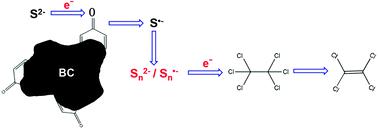当前位置:
X-MOL 学术
›
Environ. Sci.: Processes Impacts
›
论文详情
Our official English website, www.x-mol.net, welcomes your feedback! (Note: you will need to create a separate account there.)
Surface quinone-induced formation of aqueous reactive sulfur species controls pine wood biochar-mediated reductive dechlorination of hexachloroethane by sulfide.
Environmental Science: Processes & Impacts ( IF 5.5 ) Pub Date : 2020-08-04 , DOI: 10.1039/d0em00307g Shujun Yin 1 , Chenhui Wei 1 , Dongqiang Zhu 1
Environmental Science: Processes & Impacts ( IF 5.5 ) Pub Date : 2020-08-04 , DOI: 10.1039/d0em00307g Shujun Yin 1 , Chenhui Wei 1 , Dongqiang Zhu 1
Affiliation

|
Understanding the mechanisms controlling the redox transformation of organic contaminants mediated by biochar is of great significance for application of biochar in remediation of contaminated soils and sediments. Here we investigated the mediation effect of a pine wood-derived biochar (P-char) in comparison with multiwalled carbon nanotubes (MCNTs) and graphite on the reductive dechlorination of hexachloroethane by sulfide. Upon normalization of the mediator's surface area, the reduction rate of hexachloroethane follows an order of P-char < MCNTs < graphite. Aqueous polysulfides and polysulfide free radicals were readily produced by reacting sulfide only with P-char, and the supernatant separated from the reaction system could account for 83.4% of the pseudo-kinetic rate constant of hexachloroethane mediated by P-char. In contrast, MCNTs and graphite had weak abilities to produce reactive sulfur species, and the supernatant exhibited very low reduction capability (<20.7%) of hexachloroethane. Electron paramagnetic resonance (EPR) analysis demonstrated that the surface quinone moieties on P-char induced the formation of polysulfides and polysulfide free radicals from sulfide by serving as one-electron acceptors. Consistently, polysulfides prepared by reacting elemental sulfur with sulfide showed much stronger reducing capability compared to sulfide. Thus, the mediation effect of P-char was dominantly attributed to the surface quinone-induced formation of reactive reducing sulfur species, whereas the mediation effect of MCNTs and graphite mainly stemmed from the enhanced electron transfer by the graphitized carbon. These results showed for the first time that surface quinone-induced formation of aqueous reactive sulfur species could control biochar-mediated reductive dechlorination of chloroorganic contaminants by sulfides.
中文翻译:

表面醌诱导的水性活性硫物质的形成控制了松木生物炭介导的硫化物对六氯乙烷的还原脱氯。
理解控制生物炭介导的有机污染物氧化还原转化的机制,对于生物炭在污染土壤和沉积物中的应用具有重要意义。在这里,我们研究了与多壁碳纳米管(MCNT)和石墨相比,松木衍生的生物炭(P-char)对硫化物还原六氯乙烷的脱氯作用。介体表面积标准化后,六氯乙烷的还原速率遵循P-char <MCNTs <石墨的顺序。仅通过使硫化物与P-char反应就可以容易地产生含水多硫化物和多硫化物自由基,从反应体系中分离出的上清液占P-char介导的六氯乙烷的拟动力学速率常数的83.4%。相反,MCNT和石墨具有弱的产生活性硫的能力,上清液对六氯乙烷的还原能力非常低(<20.7%)。电子顺磁共振(EPR)分析表明,P-char上的表面醌部分通过用作单电子受体诱导了硫化物形成多硫化物和多硫化物自由基。一致地,与硫化物相比,通过元素硫与硫化物反应制备的多硫化物显示出更强的还原能力。因此,P-char的介导作用主要归因于表面醌诱导的反应性还原硫物种的形成,而MCNT和石墨的介导作用主要源于石墨化碳增强的电子传递。
更新日期:2020-09-23
中文翻译:

表面醌诱导的水性活性硫物质的形成控制了松木生物炭介导的硫化物对六氯乙烷的还原脱氯。
理解控制生物炭介导的有机污染物氧化还原转化的机制,对于生物炭在污染土壤和沉积物中的应用具有重要意义。在这里,我们研究了与多壁碳纳米管(MCNT)和石墨相比,松木衍生的生物炭(P-char)对硫化物还原六氯乙烷的脱氯作用。介体表面积标准化后,六氯乙烷的还原速率遵循P-char <MCNTs <石墨的顺序。仅通过使硫化物与P-char反应就可以容易地产生含水多硫化物和多硫化物自由基,从反应体系中分离出的上清液占P-char介导的六氯乙烷的拟动力学速率常数的83.4%。相反,MCNT和石墨具有弱的产生活性硫的能力,上清液对六氯乙烷的还原能力非常低(<20.7%)。电子顺磁共振(EPR)分析表明,P-char上的表面醌部分通过用作单电子受体诱导了硫化物形成多硫化物和多硫化物自由基。一致地,与硫化物相比,通过元素硫与硫化物反应制备的多硫化物显示出更强的还原能力。因此,P-char的介导作用主要归因于表面醌诱导的反应性还原硫物种的形成,而MCNT和石墨的介导作用主要源于石墨化碳增强的电子传递。



























 京公网安备 11010802027423号
京公网安备 11010802027423号